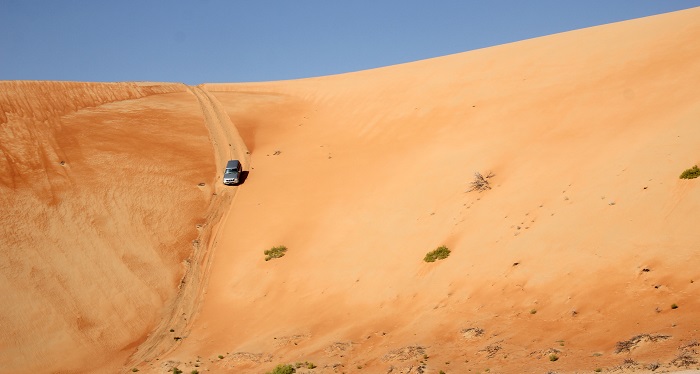Here in the UAE, the prevailing wind is from the North, meaning our dunes are formed mostly in an east-west configuration, some to over a hundred metres in height. The point where the build-up stops and loose particles of sand start to flow over the top is called a slipface. Love them or hate them, high slip faces are a common feature in the dunes of the UAE, particularly in Liwa, so if you are a budding offroader it’s important to learn how to navigate them carefully and under control.
I always suggest to offroaders that you go over the top as slowly as possible – you can always speed up on the way down.

- Unless you are an advanced driver with many slip faces under your belt, it is best to go straight down – the reason being that the weight of your engine will pull the car to the foot of the slip face.
- It can be tempting to jam on the brakes once over the top but this is not advised–when you press the brake pedal, your front brakes are applied a split-second before the rear ones, causing your front wheels to dig into the sand. In extreme cases this knee-jerk reaction could even cause your car to roll head over heels.
- If you must slow down, then gently tap the brake pedal. Or, if you need to come to a full stop quickly then pull on the handbrake – this will apply the brakes to the rear wheels only. It does tend to shorten the life of your handbrake cable but that’s a small price to pay if it prevents a mishap!
- If you feel the rear of your car kick-out to the side, which is common with short wheelbase cars, you should never apply the brake as this exacerbates the situation – if your car ends up at 90 degrees to the bottom of the slip face there is a high chance of a rollover!
- The best way to correct a rear slide is to gently tap the accelerator – the tiny burst of power will pull your car back on to a straight line. On your first few slip faces this is counter-intuitive but with a little practice you will soon master the manoeuvre.
- When navigating a slip face, your car is effectively riding an avalanche of sand; if you come to halt near the bottom, the river of sand will bypass you!
- If you are the leading car try to work out what will meet you at the foot – is it sabkhah, soft sand or a gravel mound? Is the run-off gentle or is it a sharp angle? Gentle run-offs on a sabkhah can be met with more speed than if you hit a gravel mound. At the top, if you are aligned with a tree, a lake or a huge pile of stones, it may be worth asking the next car to give you a pull-back. I’m often asked “how do you know what’s over that crest” and I have to tell my passengers, “I don’t – it’s a surprise!”
In “Arabian Sands,” explorer and author Sir Wilfred Thesiger writes about the singing sands. These can be set off by a camel or even a man walking but the best effect can be had when a few 4X4s hit a high and dry slip face. The singing sands are not particularly tuneful but they really roar when a car triggers them and you can feel the vibration of tons and tons of sand as it makes its way to the bottom. Not every desert has this phenomenon, but it is commonly heard in Liwa where the particle size and sand composition create perfect conditions. Definitely one for the UAE bucket list!

The largest slip faces can be found in Liwa, where they are up to a 110 metres from top to bottom – lots of brochures talk about drops of 300 metres in the UAE but this is not the case; the top of many dunes are 300 meters above sea level but the ground below is 170-200 metres above sea level too.
Practice on small slip faces first – the theory is the same but the consequences will be less severe if you get it wrong. Our team always take new drivers out to Al Hayer or Sweihan before heading to Liwa.
Words by: Marina Bruce
Photos by: Marina Bruce, Amro Abu Kuhail, Mark Bromfield

